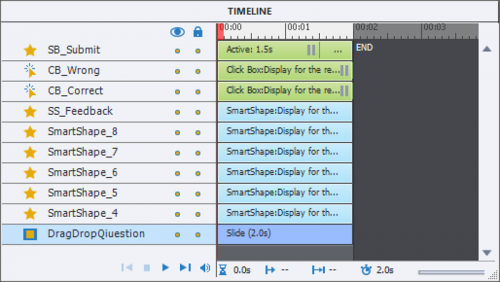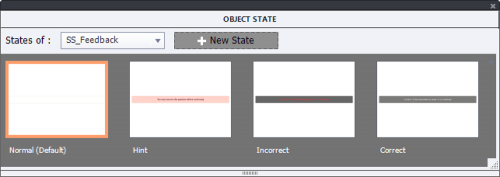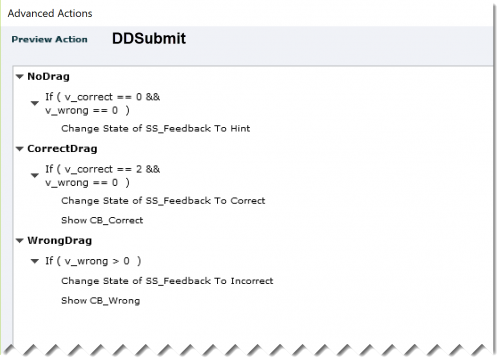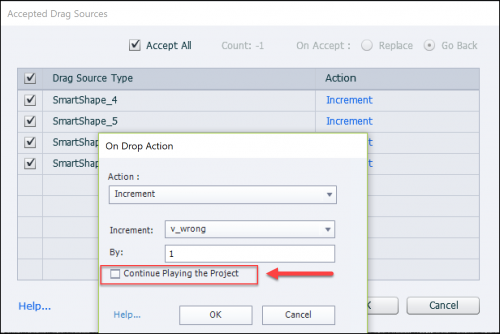Answer to a question: how to make a D&D behave totally like other questiobs, including Hint message and two-step submit process.
Use Case
Drag&Drop slides are often used as another type of questions. But its behavior is not totally the same. The typical two-step Submit process is missing:
- Tap the Submit button, feedback messages appear. One of them is the Hint message “You must answer the question to continue’. There is a Retry message possible if you have multiple attempts on question level. There is one success message which has also the invitiation ‘Click on the slide or press Y” to start the second step of the Submit process. Same for the Failure message. You can have multiple failure messages (up till 3) if you have more attempts. During this first step the playhead remains paused at the pausing point (default time is at 1.5sec but you could have moved it).
- After clicking the slide or pressing Y, with one attempt, the playhead is released and the actions ‘On Success’ or ‘Last Attempt’ are done.
The Review situation is also different for D&D slides, compared with the default quiz slides. For that situation I already posted a blog in the past. This post is meant to answer a question in this thread
Quote “I am trying to make the D&D a quiz question and behave just like the other questions with “you must answer” if nothing is done, Correct or Incorrect when answered and only one attempt.”
A while ago I already blogged about a solution that is showing the ‘You must answer’ in a dynamic failure message. That solution required to offer at least two attempts, and didn’t mimick the whole Submit process as wanted here.
Example movie
Watch this published file, it has 3 normal questions and one D&D slide which has been set up to have a similar behavior as the other quiz slides. Too bad, was not able to embed it here, you will be navigated to the project published as Rescalable HTML:
My Solution
This is the screenshot of the Timeline of the Drag&Drop slide which I created as test case: 4 drag sources (generic names ending on 4,5,6,7 and one drop target – SmartShape_8.

Variables
I created two user variables:
- v_correct: with a default value of 0. This variable will be incremented by 1 for each correct drag action. In the use case there are maximum 2;
- v_wrong: also with a default value of 0. It will track the wrong drag actions in a similar way.
Changes to the Drag&Drop setup
- Originally the score to be added to the Quiz total was linked to the Drag&Drop slide (Reporting section). I took that score away.
- The default Submit button is dragged off the stage, will be replaced by a custom shape button (in timeline it is named SB_Submit.
- The messages indicated as Success Caption and Failure Caption (although they are often shapes) were taken away by unchecking them in the Actions tab.
- The pausing point (not visible on the Timeline) may remain, although it is not really necessary since you’ll have a Custom Submit button which can have a pausing point. If you keep both pausing points, they should be at the same time.
- All Object Actions, normally set to No Action have been changed to an Increment command. For the wrong drag actions the variable v_wrong is incremented, for the correct drag actions the variable v_correct. See screenshot below:

Feedback messages (multistate)
I replaced the feedback messages by one shape with four states:

The Normal state is invisible to the user (no fill, no stroke). The other states Hint, Incorrect and Correct have exactly the same style as in the default messages in quiz slides. Too bad that you cannot choose the style, because Quizzing styles are not available for non-quiz objects. Weird, do not know the reason for this limitation.
Interactive Objects
I already mentioned the custom Submit Button which you can give exactly the same style as the Quiz Button style (which you cannot choose from the list). That shape button in the timeline screenshot shows a pausing point, at the same time as the pausing point of the D&D slide. It was not really necessary but I prefer seeing the pausing points, which is not the case for the default one in D&D slides. The Submit button will trigger an advanced or shared action.
In the Timeline you also see two click boxes CB_Wrong and CB_Correct. Those click boxes are NOT visible in output. They do not have any feedback messages, and cover the whole slide. Difference between both:
- CB_Wrong has no score attached to it.
- CB_Correct has the score you want to attach to the D&D question.
The reason for those click boxes is explained in a very old blog post (where I used Buttons) under this link.
Report Custom Questions – part 2
Both click boxes allow also to use the shortcut key ‘y’.
Advanced Action triggered by SB_Submit
When the Submit button is clicked or tapped, three possible situations can occur:
- The learner has not dragged any drag source. In that case both variables v_wrong and v_correct will have kept their default value 0. The Hint state should appear.
- The learner has dragged sources but at least one was wrong. In that case the variable v_wrong will have a value greater than 0. Not only the InCorrect state of the message shape has to appear but also the click box which has no score, CB_Wrong.
- The learner has done only correct drag actions, no incorrect actions. The Correct state has to appear and the click box which has a score CB_Correct.
Here is the Preview of that advanced action:

Remarks
The proposed solution can not be used in a responsive project created with Fluid Boxes because of its strict 2-dimension rule: you cannot stack objects in the same location as is the case here for the click boxes (which are amongst the forbidden objects in Fluid Boxes). In that case you will have to replace them by buttons which are not covering up any other object.
If you want to use this workflow in more projects, I would convert the advanced action to a shared action, and create some extra object styles in a custom theme: styles for the messages and for the button. The conversion to shared action would be an interesting use case, because of the many literals… maybe next blog.
You must be logged in to post a comment.










